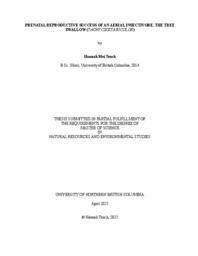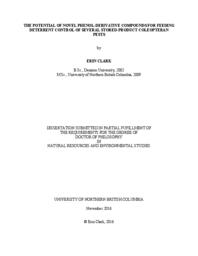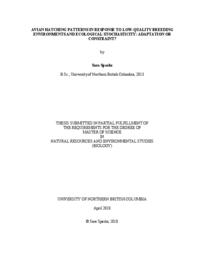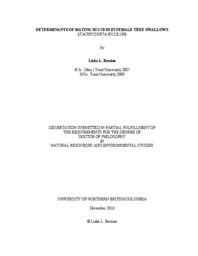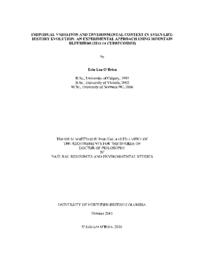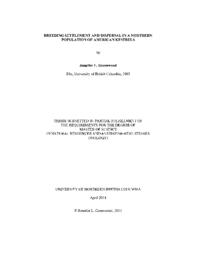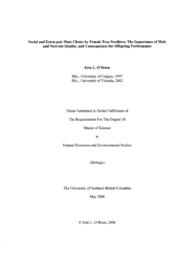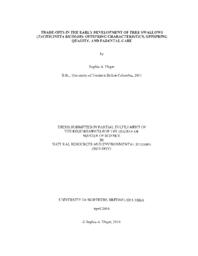Dawson, Russell
Person Preferred Name
Russell Dawson
Related Works
Content type
Digital Document
Origin Information
Content type
Digital Document
Description / Synopsis
Many animals spend a considerable amount of time within a shelter, and shelter availability can influence the distribution, abundance, and diversity of animal populations. Shelters used during winter, when ambient temperatures are low (< 0°C), must provide animals with adequate protection to survive through months of adverse conditions. For bats, shelters (roosts) used during winter must also provide microclimates that support energetic requirements for hibernation. Silver-haired bats (Lasionycteris noctivagans) are a tree-roosting species that are migratory throughout much of their range. In parts of northwestern North America, however, they may hibernate locally. Hibernation sites (hibernacula) in regions where winter temperatures are below freezing are typically caves, underground mines, or rock crevice features, as these protect bats from cold temperatures and provide a humid environment that prevents dehydration. In a forested area near Beasley in southern British Columbia, silver-haired bats use an abandoned mine, rock crevices, and trees as roosts during winter. The use of trees as roosts during winter in cold regions (average temperatures < 0°C) is poorly understood. I sought to investigate the winter ecology of tree-roosting silver-haired bats in southern British Columbia. In Chapter 2, I described the characteristics of trees used as hibernacula by silver-haired bats. I hypothesize that bats select winter roost trees non-randomly, and differently across seasons. In Chapter 3, I investigated microclimates and torpor patterns inside silver-haired bat mine, tree, and rock crevice hibernacula. I hypothesize that microclimates vary among winter roost types, and because of these differences, torpor, arousal and movement patterns will differ among tree, rock crevice and mine winter roosts. A majority (66.7%, n = 22) of silver-haired bats used trees as winter roosts during the study. Winter tree roosts were selected non-randomly, and compared to summer roosts, bats used features that provided insulation, such as, cavities in large-diameter, low-decay trees in areas of low canopy closure. Winter trees roosts were colder but more humid compared to the mine and rock crevice roosts. Bats switched among roosts throughout winter depending on ambient conditions but did not alter torpor patterns among roost types. Bats typically used humid roosts (trees) on drier days, and less humid roosts (mine) on more humid days. Further, bats used the well-insulated mine on colder days, and poorly insulated trees and rock crevice roosts on warmer days. Despite this, bats showed more tolerance for colder roost temperatures than expected, remaining in trees during periods of cold (-9°C) temperatures. I conclude that there may be a trade-off between roost humidity and temperature, with bats using multiple hibernacula to optimize energetic benefits in the context of ambient conditions. Trees are an important part of silver-haired bat winter ecology. The use of trees as hibernacula needs to be better understood to inform forest management decisions that better support silver-haired bat conservation by protecting important winter roosts
Origin Information
Content type
Digital Document
Description / Synopsis
The strategic allocation of resources to maximize fitness is the organizing principle shaping the evolution of life histories. The physiology and behaviour of animals is a manifestation of trade-offs in resource allocation among traits and activities that benefit current or future reproduction. In theory, traits subject to such trade-offs are expected to show negative correlations, but numerous field studies have documented apparent contradictions to theoretical expectations: in some populations, parental effort (allocation to current reproduction) and reproductive performance (i.e., a fitness component) are not negatively correlated to self-maintenance (allocation to future reproduction). One explanation for such findings is that inter-individual variation in resource acquisition can obscure trade-offs by altering the overall quantity of resources individuals are able to invest. Acquisition may influence both the quantity of resources allocated in trade-offs as well as reproductive success. Asymmetries in acquisition may be the product of differences in intrinsic quality (individual phenotypes) and/or environmental factors (territory quality). In a population of breeding mountain bluebirds (Sialia currucoides), I sought to determine how resource acquisition varied, and to identify how it may affect life-history trade-offs and reproductive performance. In my research, I used several lines of inquiry to characterize how resource acquisition varies and affects trade-offs in the study population. First, I showed that offspring quality, a contributor to fitness, is influenced by the types of prey nestling bluebirds are fed by their parents, and that the resources parents provide to their broods vary seasonally and as their nestlings age. Next, I used a short-term manipulation of brood age to find that parents have limited flexibility in their capacity to acquire resources while provisioning broods, which may be due to intrinsic or extrinsic constraints. I then identified relationships among the landscape characteristics of breeding territories (extrinsic factors, potentially influencing acquisition) and the reproductive performance of bluebirds, over an 11-year period. These characteristics, elevation and distance to forest edges, are subsequently linked to differences in microclimate, microhabitat, and parental prey use, providing a partial explanation for why occupancy and reproductive success are spatially clustered and consistent over time. Finally, I used a brood size manipulation to induce changes in parental effort, revealing that acquisition (quantified as both individual and territory quality) influences how mountain bluebirds trade-off one proxy for self-maintenance (energy metabolites) with providing food to their offspring. Interestingly, these effects differed between the sexes. Females generally biased allocation towards current reproduction, increasing provisioning to larger broods, regardless of territory quality; females on low-quality territories subsidized increased provisioning activity by catabolizing stored resources. In contrast, only males on high-quality territories increased parental effort in response to larger broods, and among these individuals, only high-quality males incurred an energy deficit to subsidize this activity. My findings showed that resource acquisition may be critical to understanding why trade-offs differ among individuals, and that both intrinsic and extrinsic limits on acquisition may influence the patterns of allocation we observe in wild populations.
Origin Information
Content type
Digital Document
Description / Synopsis
My thesis investigates how urban noise influences the relative audibility of songs to female Mountain Chickadees (Poecile gambeli), who assess male signalling at dawn while roosting within the nest cavity. Over two breeding seasons, I monitored Mountain Chickadees breeding on an urban/rural interface in Kamloops, BC, Canada. I broadcast typical Mountain Chickadee songs, with or without added noise, towards recently unoccupied nests while simultaneously re-recording these songs with microphones outside and inside the nest box to determine the relative audibility in relation to both distance and presence/absence of noise. I then tracked individual males’ behaviour and movement during dawn signalling, while passively recording their songs with microphones — outside and inside the nest box — to determine the relative audibility of signals from the perspective of the roosting female. The relative audibility of songs decreased with increasing distance from the nest, which was compounded by increased urban noise. During dawn signalling, urban males respond to these effects by remaining closer to the nest, resulting in their songs being more audible within the nest than their rural counterparts. Overall, ambient noise and distance had an interactive effect on relative audibility of songs, suggesting complex dynamics of communication networks that may result in a trade-off, where males are forced to prioritize directing their signals to either their social mates or neighbours.
Origin Information
Content type
Digital Document
Origin Information
Content type
Digital Document
Origin Information
Content type
Digital Document
Origin Information
Content type
Digital Document
Origin Information
Content type
Digital Document
Origin Information
Content type
Digital Document
Origin Information
Content type
Digital Document
Origin Information
Content type
Digital Document
Origin Information
Content type
Digital Document
Origin Information
Content type
Digital Document
Origin Information
Content type
Digital Document
Origin Information
Content type
Digital Document
Origin Information
Content type
Digital Document
Origin Information
Content type
Digital Document
Origin Information

